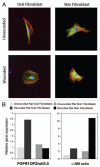Wound closure and wound management: A new therapeutic molecular target
- PMID: 20448469
- PMCID: PMC2958616
- DOI: 10.4161/cam.4.3.11917
Wound closure and wound management: A new therapeutic molecular target
Abstract
Wound closure and infection control are the primary goal of wound management. A variety of disinfectants and antimicrobial agents are widely available today and routinely achieve infection control. On the contrary, wound closure still remains a challenging goal. Cell adhesion, migration and contraction play significant roles in creating contractile force of patent wound margins and in contributing to wound closure. Modulations of these cellular behaviors have been investigated in the context of wound contraction; however, therapeutic strategy to achieve wound closure has not been established. Recently, we have reported that a previously unknown cytoskeleton molecule, wound inducible transcript-3.0 (wit3.0) also known as fibroblast growth factor receptor 1 oncogene partner 2 (FGFR1OP2), can significantly modulate fibroblast-driven wound closure in vitro and in vivo. The dynamic role of cytoskeleton in different experimental models may provide a novel platform for designing the therapeutic target of wound management.
Figures

Similar articles
-
Small cytoskeleton-associated molecule, fibroblast growth factor receptor 1 oncogene partner 2/wound inducible transcript-3.0 (FGFR1OP2/wit3.0), facilitates fibroblast-driven wound closure.Am J Pathol. 2010 Jan;176(1):108-21. doi: 10.2353/ajpath.2010.090256. Epub 2009 Dec 3. Am J Pathol. 2010. PMID: 19959814 Free PMC article.
-
Actin and myosin dynamics are independent during Drosophila embryonic wound repair.Mol Biol Cell. 2019 Nov 1;30(23):2901-2912. doi: 10.1091/mbc.E18-11-0703. Epub 2019 Sep 25. Mol Biol Cell. 2019. PMID: 31553671 Free PMC article.
-
Oral fibroblast expression of wound-inducible transcript 3.0 (wit3.0) accelerates the collagen gel contraction in vitro.J Biol Chem. 2003 Dec 19;278(51):51527-34. doi: 10.1074/jbc.M309616200. Epub 2003 Oct 3. J Biol Chem. 2003. PMID: 14527947
-
Forceful closure: cytoskeletal networks in embryonic wound repair.Mol Biol Cell. 2019 Jun 1;30(12):1353-1358. doi: 10.1091/mbc.E18-04-0248. Mol Biol Cell. 2019. PMID: 31145669 Free PMC article. Review.
-
Wound healing in embryos: a review.Anat Embryol (Berl). 1997 Mar;195(3):215-28. doi: 10.1007/s004290050041. Anat Embryol (Berl). 1997. PMID: 9084820 Review.
Cited by
-
The Role of MicroRNAs in Diabetic Complications-Special Emphasis on Wound Healing.Genes (Basel). 2014 Sep 29;5(4):926-56. doi: 10.3390/genes5040926. Genes (Basel). 2014. PMID: 25268390 Free PMC article. Review.
-
An improvement in acute wound healing in rats by the synergistic effect of photobiomodulation and arginine.Lab Anim Res. 2019 Dec 11;35:28. doi: 10.1186/s42826-019-0025-x. eCollection 2019. Lab Anim Res. 2019. PMID: 32257915 Free PMC article.
-
Association between FGFR1OP2/wit3.0 polymorphisms and residual ridge resorption of mandible in Korean population.PLoS One. 2012;7(8):e42734. doi: 10.1371/journal.pone.0042734. Epub 2012 Aug 6. PLoS One. 2012. PMID: 22880093 Free PMC article.
-
Identification of genetic loci associated with higher resistance to pancreas disease (PD) in Atlantic salmon (Salmo salar L.).BMC Genomics. 2020 Jun 3;21(1):388. doi: 10.1186/s12864-020-06788-4. BMC Genomics. 2020. PMID: 32493246 Free PMC article.
-
Trauma induces overexpression of Cx43 in human fetal membrane defects.Prenat Diagn. 2017 Sep;37(9):899-906. doi: 10.1002/pd.5104. Epub 2017 Aug 1. Prenat Diagn. 2017. PMID: 28664994 Free PMC article.
References
MeSH terms
Substances
LinkOut - more resources
Full Text Sources
Other Literature Sources
Molecular Biology Databases
